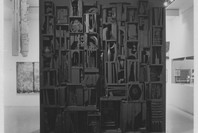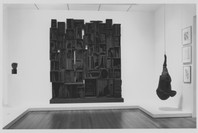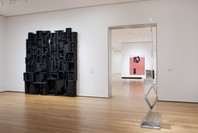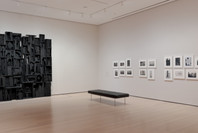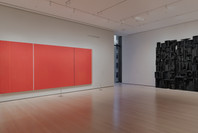Louise Nevelson called herself “the original recycler.” To make this sculpture, she filled open boxes with wooden pieces she found on the street. Things like chair backs, furniture legs, and scraps from old buildings. She painted everything black and stacked the boxes on top of one another.
Notice how Nevelson arranged the pieces. Look for places where she layered or overlapped them. Find a spot where she spaced pieces farther apart. Do you see any pieces hanging upside down?
Kids label from 2023
Although Sky Cathedral— with its large scale and monochromatic palette—resembles paintings from the same decade, it quickly reveals richly layered depth. Its open shallow boxes, fitted together like a jigsaw puzzle, are filled with salvaged wood pieces including moldings, dowels, spindles, and architectural ornaments. Nevelson painted all the parts black, unifying them visually while also obscuring their original identities. “For me it is the total color,” she said. “It means totality. It means: contains all.” Like some of her contemporaries, Nevelson was interested in the sublime and spiritual transcendence. Sky Cathedral is like a shrine filled with everyday objects found in her Manhattan neighborhood.
Gallery label from 2023
As a rectangular plane viewed from the front, Sky Cathedral has the pictorial quality of a painting —perhaps one of the preceding decade’s Abstract Expressionist canvases, which share its ambitious scale—but it quickly reveals richly layered depth. Its intricacy lies in both the method of its construction—it is made of shallow open boxes fitted together like a jigsaw puzzle—and those boxes’ contents, the salvaged wood bits and pieces with which Nevelson filled many of her works. These include moldings, dowels, spindles, chair parts, architectural ornaments, and scroll-sawed fragments. Nevelson made this material into a high wall that is variegated by a play of flatness and recession, straight lines and curves, overlappings and vacancies.
In this and in many other works, she painted every object and box the same dully glowing black, unifying them visually while also obscuring their original identities. “I don’t think I chose it for black,” Nevelson reflected of this decision. “I think it chose me for saying something. You see, it says more for me than anything else.... For me it is the total color. It means totality. It means: contains all.”
Publication excerpt from MoMA Highlights: 375 Works from The Museum of Modern Art, New York (New York: The Museum of Modern Art, 2019)
Sky Cathedral consists of boxes stacked against a wall, each compartment filled with wooden scraps including moldings, dowels, spindles, and furniture parts. Nevelson then covered the entire assemblage with black paint, both unifying the composition and obscuring the individual objects. She once explained her fascination with the color black: “When I fell in love with black, it contained all color. It wasn’t a negation of color. It was an acceptance. Because black encompasses all colors. Black is the most aristocratic color of all. … You can be quiet and it contains the whole thing.”
Although primarily a sculptor, Nevelson shared with Abstract Expressionist painters an interest in creating large works that play with line, flatness, and scale. Like her contemporaries Mark Rothko and Barnett Newman, Nevelson was interested in the sublime and spiritual transcendence. Sky Cathedral, like many of Nevelson’s wall pieces, evokes the sense of a shrine or a place of devotion. The artist wrote that, in her art, she sought “the in-between places, the dawns and dusk, the objective world, the heavenly spheres, the places between the land and the sea.”

